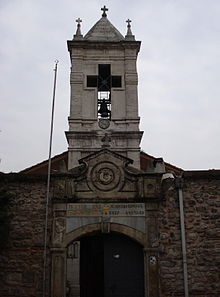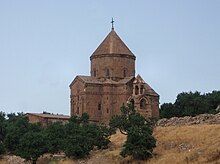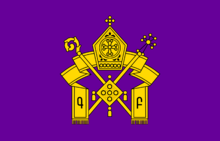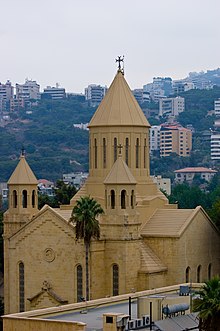Armenian Apostolic Church



The Armenian Apostolic Church ( Armenian Հայ Առաքելական Եկեղեցի , transcription Eastern Armenian : Haj Arakelakan Jekeghezi ; official name also: Armenian Հայաստանյայց Առաքելական Սուրբ Եկեղեցի , transcription Eastern Armenian: Hajastanjajz Arakelakan Surb Jekeghezi , Holy Apostolic Church of Armenians) is an ancient oriental church today nine million Armenians in two Catholics ( Echmiadzin , Sis ), two patriarchates ( Jerusalem , Constantinople ) and around 30 dioceses , nine of them in Armenia .
history
The Armenian Apostolic Church is the oldest “self-sufficient” ( sui juris ) state church in the world. It claims to go back to apostolic foundation. According to tradition, the apostles Judas Thaddaeus and Bartholomew preached, founded Christian communities and suffered martyrdom in Armenia in the second half of the first century . The first mention of Armenian Christians can be found in the pamphlet "Adversus Judaeos" by Tertullian , written around 197 .
The name "Gregorian Church" is derived from the patron saint of the Armenian people, Gregory the Illuminator , ie the Baptist. King Trdat III. who had been converted by Gregory, elevated Christianity to the state religion ; According to tradition, this happened in 301, according to historical research probably in 314. In any case, Armenia is the oldest Christian state in the world. According to legend, Gregory had the first church built in Ashtishat , the founding of the first church in Etschmiadzin is also traced back to Gregory.
Legend has it that the Armenians threw Gregor the lion to eat because he preached the Christian faith. But the starving lions did not eat Gregor; The Armenians interpreted this as a sign from God, and they became Christians. Mesrop Mashtots created the Armenian alphabet and translated parts of the Bible into Armenian in this script . The teaching of the (Imperial) Council of Chalcedon in 451, in which no bishop from Armenia had participated, was rejected by the Synod of the Armenian Apostolic Church in 506. For this reason, the Armenian Apostolic Church is counted together with the Coptic , Ethiopian , Eritrean , Syrian Orthodox and Malankar Church to the pre-Chalcedonian “Oriental Orthodox Churches” or Old Oriental Churches .
In the 5th century, Euthymius , an Armenian from Melitene , established monastic life in the Judean desert . Numerous monasteries in Jerusalem have wholly or partly Armenian residents until modern times. It was not until the persecution of the so-called “ Monophysites ”, which also included the Armenian Christians, under the emperors Justin I and Justinian I, that Jerusalem's Christianity split into an Orthodox and an Armenian denomination. After the occupation of Jerusalem by the Sassanids (614–628), the Armenians participated on a large scale in the reconstruction of the holy places.
In the Middle Ages, Armenian kings transferred their dominions in Caucasia more or less voluntarily to the Byzantine Empire , and settled with their followers mainly in Cappadocia . In the period that followed, the Kingdom of Lesser Armenia was established in Cilicia . The church leadership followed this movement. As a result, the " Catholicos of the Armenians" resided in Cilicia for the longest time, up to the beginning of the 20th century, in Sis . Today the Catholic of Cilicia has its center in Antelias (Lebanon).
The Armenians who remained in the east ("Greater Armenia") founded Catholics in Aghtamar , Gandsassar and Etschmiadzin in the 12th and 15th centuries , of which the latter (from 1828 under Russian rule) was able to achieve the leading position within the Armenian Apostolic Church .
Today there is a large Armenian diaspora , which has spread the Armenian Apostolic Church worldwide.
The October Revolution of 1917 affected Armenia after three years: in 1920 the independent Republic of Armenia was transformed into a Soviet socialist republic . At the end of the year, the situation for church institutions changed. All cultural institutions were nationalized and religious objects were banned in public. In the following period atheism was propagated. To counter this propaganda, a group was formed under the name “Living Church”, led by the archpriest Alexander Vedenskij. Since the goals of this group could not be brought together with those of the Armenian Church, it found no approval and soon disappeared again. The Catholicos Georg V continued his work despite the pressure from the Soviet government until his death on May 9, 1930.
After his death in November 1932 Archbishop Khoren Muradbegian became the new Catholicos . Stalin's power increased and the situation in Armenia became unbearable. In 1936 the Soviet regime eliminated hundreds of intellectuals, writers, artists, clerics and statesmen. In 1937 Khoren wanted to present his plans for reform to the Patriarchs of Cilicia, Jerusalem and Constantinople, as well as to all Armenian bishops. But due to his sudden death in 1938 it did not come to that. The circumstances of his death are not exactly clear; however, there are different assumptions. On the one hand, there is a report of a heart attack, on the other hand, that he was strangled or poisoned. It is assumed that the acts were carried out by the Soviet government.
Due to the support of the Soviet army by the Armenian Church and the high and loss-making participation of Armenians in the defense of the Soviet Union - many Armenians hoped for revenge for the support of the Ottoman Empire by the German Empire in World War I - it came about in World War II an improvement in the situation of the Church. Archbishop Gheorg Khachaturovich Cheorekchian, who later became Catholicos George VI. , called for a fundraising campaign in the diaspora (especially in Syria , Lebanon , Iran and the USA), from the proceeds of which the 119th Sasunc'i Dawit tank regiment, named after a national hero, was financed. This was placed under the Soviet Army on February 29, 1944. On April 19, 1945, Georg VI. the opportunity for a personal conversation with Stalin, which presumably dealt with the following problems of the Armenian people:
- Reorganization of the dioceses within Soviet Armenia.
- Election of a new Catholic.
- Reopening of the seminary.
Exact records of the conversation between George VI. and Stalin does not exist. Ten days after this meeting, the Soviet army marched into Berlin. After the end of the war in 1945, Georg was awarded the "Medal for the Defense of the Caucasus". At the end of 1944 he had invited delegates from all Armenian dioceses to elect a new Catholic. On June 22, 1945 Georg was elected as the new Catholicos. During his reign, the Congregation was revived and in 1917 closed seminar on November 1, 1945 Echmiadzin reopened. In addition, George reorganized the dioceses of Armenia. Until his death on May 9, 1954, he successfully campaigned for the re-establishment of the Armenian Church.
Wasgen I was elected Catholicos on September 30, 1955 . This led the with Georg VI. started renewal movement. After the independence of the Republic of Armenia, he swore in 1991 its first president Levon Ter-Petrosyan . Wasgen died of old age on August 18, 1994. He was followed by from Kessab in Syria originating Catholicos of Cilicia , Karekin I , when Karekin I, Office of the Catholicos of Echmiadzin after. His attempt to unite the two Catholics into one failed, however. Karekin I ordained Aram Keshishian on July 1, 1995, as Catholicos of Cilicia. Karekin Sarkissian died of cancer in 1999. So on October 27, 1999, Karekin Nersissian became Karekin II. Catholicos in Echmiadzin.
Return of Confiscated Properties

In August 2011, then Turkish Prime Minister Erdoğan decided by decree to return property and sacred buildings confiscated in the past to Turkey's Christian minorities , including the Armenian Apostolic Church. The Patriarch of Constantinople Bartholomäus I and representatives of the European Union reacted positively and praised the decision as reparation for earlier injustices. The return of the confiscated real estate is a requirement of the EU in Turkey's accession negotiations with the European Union . Nevertheless, priests are still not allowed to be trained in seminaries.
Dioceses
- Catholic of all Armenians from Echmiadzin with Anatolia , Aradznortaran , Aragazotn , Ararat , Armavir , Athens , Baghdad , Buenos Aires , Bucharest , Damascus , Gegharkunik , Geneva , Georgia , Cairo , Karabag , Kiev , Cologne ( Diocese of the Armenian Church in Germany ), Kotajk , Kukark , London , Los Angeles , Lyon , Marseille , Central Europe-Sweden , Montevideo , Montreal , New York , Nor-Nachicevan , Russia , Schirak , Sjunik , Ukraine , São Paulo , Switzerland , Sofia , Sydney , Vienna ( Diocese for Central Europe and Scandinavia )
- Catholic of Cilicia : Sis , today headquarters in Antelias (Lebanon) with: Aleppo , Beirut , Culfa , Canada , Kuwait , Tabriz , Tehran , Venezuela , Cyprus
- Patriarchate of Jerusalem : Jerusalem , Amman
- Patriarchate of Constantinople : Istanbul , Diyarbakır , Scutari
cult
Order of Worship and Holy Liturgy
The Armenian Church is a singing and praying church. The celebration of the Holy Liturgy takes place every Sunday. In addition to this there are nine daily prayers in the Armenian Church. These consist of the night prayer, the morning prayer, the sunrise prayer, the prayer at the third hour, the prayer at the sixth hour, the prayer at the ninth hour, the evening prayer, the peace prayer and the prayer for rest.
The Holy Liturgy is celebrated according to the missal of the Armenian Apostolic Church. As described in this, the holy liturgy consists of four parts: the preparation, the synaxis or the word service, the holy liturgy or the sacrificial service, and finally the blessing and the dismissal. The preparation consists of confession, clothing, washing the hands, entering and making the prosthesis (equipment). The entrance, Trishagion (praising the Trinity), the readings and the creed are characteristic of the Synaxis. There are three creeds in use in the Armenian Church: the Nicene-Constantinople Creed, the Baptismal Creed and the Creed of Grigor Tatevatzi (14th century). The Nicaea's creed is used in the divine service. This is followed by the Holy Liturgy or the sacrificial service. This consists of sacrifice, the greeting of peace, sanctification, commemoration and the Lord's Supper. The service ends with thanksgiving, reading of the last gospel, prayer for blessing, and dismissal.
The Holy Liturgy can only be presided over by an ordained minister; Clergymen can be married or celibate. At the altar he is assisted by deacons. The church present also contributes to the celebration. Traditionally, their voice is represented by the singing of the acolytes or the choir, in which all baptized are allowed to be members. The church music of the Armenian Church is not based on a European key, but on a tetrachord system . Here the major fourth is the predominant fourth, the beginning and end of which remain the same. Six of these fourths form the Armenian melodies.
Tukh Manuk is a black youth revered in the folk religion, who was adopted from pre-Christian myths and is venerated at some shrines.
The church art of the Armenians
The Christian faith of the Armenians is reflected in the architecture as well as in sculptures and paintings. The architectural heyday coincides with state independence in the 9th to 11th centuries. The special Armenian style shows influences from Syria, Persia and Byzantium. Typical of the Armenian architectural style are the "vaulted ceilings", the use of a rubble mixture and "rapidly setting mortar", the large, detailed surfaces of the outer facades, which are structured by columns and arches, and the irregular inner walls of the church. Furthermore, the floor plan is characteristic, which consists of three short, basic naves, which could be extended in a cross shape. The vault is then provided with a stone gable roof in the shape of a cross. In the 7th century, a dome came over the roof crossing. In memory of Mount Ararat, these domes were covered with a stone pyramid roof.
Church celebrations
- On Surb and on January 6th, the birth of Christ is celebrated according to the Catholic, Protestant and Orthodox Christmas and the baptism of Jesus ( jrorhnek ).
- Trndes, the representation of the Lord , is celebrated with a bonfire 40 days after the birth of Christ on the evening of February 14th.
- Zaghkasard is Palm Sunday one week before Easter.
- Satik, Easter
- Hambardsum, Ascension Day on the 40th day after Easter
- Vardawar , Feast of Conversion, 14 weeks after Easter
- Surb Chatsch, also Chatschweraz, the Exaltation of the Cross , will be celebrated on the next Sunday, September 14th.
See also
- List of Katholikoi of the Armenian Apostolic Church
- List of the Catholikoi of Cilicia of the Armenian Apostolic Church
- List of Katholikoi of Aghtamar of the Armenian Apostolic Church
- List of Patriarchs of Constantinople of the Armenian Apostolic Church
- List of Patriarchs of Jerusalem of the Armenian Apostolic Church
- Armenian rite
literature
- Lothar Heiser : The testimony of faith of the Armenian Church (= Sophia 22). Paulinus-Verlag, Trier, 1983, ISBN 3-7902-1408-6 .
- Friedrich Heyer (ed.): The Church of Armenia . A people's church between East and West. Evangelisches Verlagswerk, Stuttgart 1978, ISBN 3-7715-0187-3 .
- Mesrob K. Krikorian: The Armenian Church: Materials on Armenian History, Theology and Culture. 2nd Edition. Lang, Frankfurt am Main 2007, ISBN 978-3-631-55892-8 .
- A. Ter-Mikelian: The Armenian Church in its relations with the Byzantine from IV. To XIII. Century . Leipzig 1892.
- E. Ter-Minassiantz: The Armenian Church in its relations with the Syrian churches up to the end of the 13th century (TU 11.4). Leipzig 1904.
- Karl Pinggéra : The Armenian Apostolic Church . In: Christian Lange , Karl Pinggéra (ed.): The old oriental churches. Belief and history . Scientific Book Society, Darmstadt 2010, ISBN 978-3-534-22052-6 , pp. 51-62 .
- VS Ghougassian: The Emergence of the Armenian Diocese of New Julfa in the 17th Century . Scholars Press, Atlanta 1998, ISBN 0-7885-0438-X .
- Hacik Rafi Gazer : The reform efforts in the Armenian Apostolic Church in the late 19th and first third of the 20th century (= Church in the East . Volume 24). Vandenhoeck & Ruprecht, Göttingen 1996, ISBN 3-525-56442-2 .
- Hacik Rafi Gazer: The Armenian Church in Soviet Armenia between the World Wars. Anatomy of an annihilation . Lit, Münster 2001, ISBN 3-8258-5555-4 (= studies on oriental church history . Volume 14).
- Martin Tamcke : Armin T. Wegner and the Armenians. Claim and reality of an eyewitness . Lit, Hamburg 1996, ISBN 3-8258-2803-4 (= studies on oriental church history. Volume 2).
- Germany and Armenia 1914–1918. Collection of diplomatic files . Edited and introduced by Johannes Lepsius . With a foreword to the new edition by Tessa Hofmann and an afterword by M. Rainer Lepsius . Reprint of the edition Donat & Temmen , Bremen 1986, published by Tempelverlag in Potsdam in 1919 , ISBN 3-924444-22-6 .
- Diradur Sardaryan: The Mystery of the Sacred Liturgy of the Armenian Apostolic Church . Armenian text and German translation by Gabriele Winkler . Holy Mother Seat of Etchmiadzin, Etchmiadzin 2012, ISBN 978-9939-59-108-7 .
- Diradur Sardaryan: Surb Patarag - The Holy Liturgy of the Armenian Apostolic Church. An introduction (= Studies on Oriental Church History . Volume 51). Lit, Berlin 2017, ISBN 978-3-643-13154-6 .
Web links
- Diocese of the Armenian Church in Germany
- Armenian Apostolic Church Community Austria
- Diocese of the Armenian Church in Switzerland
- The Armenian Church - The Mother See of Holy Etchmiadzin.
- Armeniapedia: Armenian Apostolic Church.
- Letter from Pope John Paul II to Catholicos Aram I (May 20, 2001)
Individual evidence
- ^ The Armenian Church Today: Current Structure . Website of the "Armenian Church - Mother See of Holy Etchmiadzin", accessed on July 5, 2016 (English).
- ↑ Martin Tamcke: The orthodox Christianity. 2nd Edition. Beck, Munich 2007, p. 29.
- ↑ Michel Jean van Esbroeck: Le roi et l'Sanatrouk apôtre Thaddée. In: Revue des études arméniennes. (REA), Vol. 9 (1972), pp. 241-283.
- ^ Tertullian: Adversus Judaeos. VII, 4.
- ↑ Max Küchler, Klaus Bieberstein: Jerusalem . Vandenhoeck & Ruprecht, 2007, ISBN 978-3-525-50170-2 , p. 540.
- ^ Friedrich Heyer (ed.): The Church of Armenia: A People's Church between East and West . Evangelisches Verlagswerk, Stuttgart 1978, ISBN 3-7715-0187-3 .
- ↑ Steffen Wurzel : Turkey returns real estate to minorities. (No longer available online.) Tagesschau.de , August 30, 2011, archived from the original on February 19, 2012 ; accessed on June 30, 2016 .
- ↑ Order of worship . ( Memento from June 28, 2016 in the Internet Archive ) Website of the Diocese of the Armenian Church in Germany, accessed on June 30, 2016.
- ↑ a b General information: Holy Liturgy / Ս. Պատարագ . ( Memento from August 26, 2016 in the Internet Archive ) Website of the Diocese of the Armenian Church in Germany, accessed on June 30, 2016.
- ↑ Creed . Website of the Diocese of the Armenian Church in Germany, accessed on August 31, 2017.
- ↑ Komitas Keworkian: The Armenian Church Music. I. The Armenian punctuation system . In: Anthologies of the International Music Society 1 vol. 1 (November 1899), pp. 54–64. Franz Steiner Publishing House; Retrieved July 5, 2016.
- ↑ Heiser: The testimony of the Armenian Church. P. 28.
- ↑ Heiser: The testimony of the Armenian Church. P. 29.
- ↑ Heiser: The testimony of the Armenian Church. P. 30.




